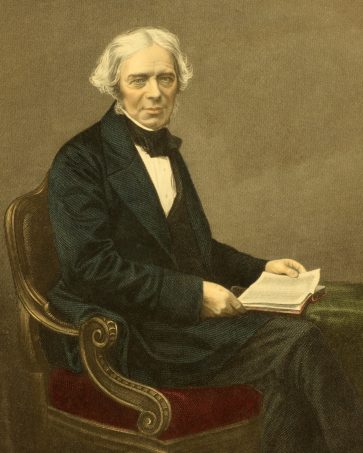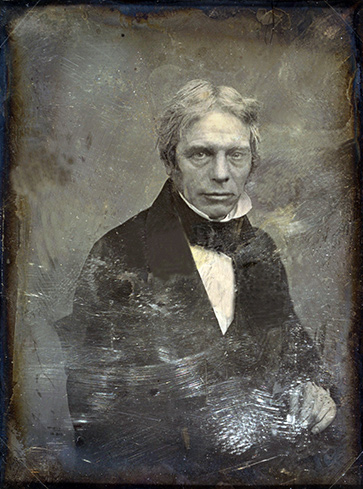Who was Michael Faraday?
The Faraday Institute is named after Michael Faraday because he combined a deep religious faith with an outstanding scientific career, making him one of the best known of all British scientists, or natural philosophers as they were known in his era. At the same time Faraday was a very effective communicator of the latest findings in science in the public domain, an exemplar of how to cross inter-disciplinary boundaries.
Early career
Michael Faraday (1791-1867) discovered many of the fundamental laws of physics and chemistry, despite the fact that he had virtually no formal education. The son of an English blacksmith, he was apprenticed at the age of 14 to a bookseller and bookbinder. He read every book on science in the bookshop and attended lectures given at the Royal Institution by various natural philosophers, including Sir Humphry Davy, the discoverer of several chemical elements. In 1812, he applied to Davy for a job, citing his interest in science and showing Davy the extensive lecture notes he had taken. Davy hired Faraday to assist with his research and lecture demonstrations.
Magnetism and chemistry
Within a few years, Faraday began to do original research on his own, submitting two papers on chemistry to the Royal Society in 1820. In that same year, Oersted discovered that a current in a wire deflects a compass needle. Faraday repeated Oersted’s experiments and found that a magnet also exerts a force on a wire carrying an electric current. Soon afterward, he also showed how to liquefy chlorine, and he isolated benzene, a fundamental component of organic chemistry.
Faraday’s important discoveries brought him considerable fame, much to the discomfort of Davy, who felt he should have shared the credit for some of the advances. Davy preferred to regard Faraday as a technical assistant and even forced him to serve as a valet on an extended tour of European research centres. Despite Davy’s objections, Faraday was elected to the Royal Society in 1824 and was made director of the laboratory at the Royal Institution in 1825.
Electricity
After Faraday discovered, in 1831, that a changing magnetic field can induce a current, he performed a series of experiments that showed clearly that the induced EMF is equal to the rate of change of magnetic flux. Also, generalizing from the patterns formed by iron filings around magnets, he invented the concepts of magnetic and electric field lines. Faraday knew little mathematics and found this concrete approach to electricity and magnetism much more useful than equations giving the forces between charges or currents. He also suggested that the propagation of light through space consisted of vibrations of these lines. His concepts of electric and magnetic fields were put into mathematical form a generation later by Maxwell, who showed that light is, in fact, an oscillatory electromagnetic disturbance.
Faraday made many other notable contributions. He devised the first electrical generator, which consisted of a copper disk rotating between the poles of a magnet. He discovered the correct laws of electrochemistry after proving that earlier theories disagreed with experiments. He studied optical phenomena and found that when light passes through a medium, a magnetic field will rotate the direction of the oscillating electric field. Ignoring scorn from his contemporaries, he attempted unsuccessfully in laboratory experiments to find a link between gravitation and electromagnetism. Such a link was observed 70 years later in a test of Einstein’s general theory of relativity, when light rays passing near the sun were found to be deflected.
During the years 1831-1855 Faraday read before the Royal Society a series of 30 papers that were published in his three-volume ‘Experimental Researches in Electricity’. His bibliography lists nearly 500 printed papers, of which only three were jointly written papers. Today we might call Faraday a physicist, but the term did not come into usage until the late 1860’s, and the description ‘chemist, electrician and natural philosopher’ more clearly describes the immense range of Faraday’s investigations. By 1844 he had been elected to about 70 scientific societies, but Faraday declined nomination as President of the Royal Society. As Cantor remarks ‘…as a Christian Faraday felt that no God-given moment should be wasted. His time had to be strictly controlled. He pursued both his science and his religion with total dedication’.
Work, finish, publish
Faraday’s advice to a younger scientist to ‘Work, finish, publish’, is an aphorism that would serve as a useful reminder on the wall of any modern laboratory. Yet Faraday still found time to take a keen appreciation in the arts, read novels vociferously and spent many hours a week visiting the poor and sick in the context of his job as an elder of his local church in London. In fact he was an enthusiastic collector of engravings, lithographs, and photographs, particularly portraits. He developed lasting friendships with many of the leading artists of London and served as an advisor to the British Museum, National Gallery, and Westminster Abbey on the preservation of sculpture and architecture.
One of Faraday’s jobs in the Royal Institution was to give regular public lectures that would bring the public up-to-date on the latest scientific discoveries. There was an immense public interest in science in early Victorian England. Nervous at the start of his new responsibility, Faraday soon became a confident and gifted lecturer, incorporating experiments into his lectures and quickly establishing a rapport with his largely non-specialist audiences. His obvious enthusiasm for his subject was infectious. ‘All is a sparking stream of eloquence and experimental illustration’ enthused William Crookes after one of Faraday’s lectures. Faraday rarely alluded to religion as such during his public lectures, but the religious message was implicit in the sense of wonder that he set out to evoke in the remarkable properties of God’s world. In a private lecture given before Prince Albert in 1849 Faraday expounded the wonders of magnetism and the influence that it appeared to exert on every particle in the universe: ‘What its great purpose is, seems to be looming in the distance before us….and I cannot doubt that a glorious discovery in natural knowledge, and of the wisdom and power of God in the creation, is awaiting our age’.
Christian convictions
Faraday belonged to a small nonconformist denomination and his Christian convictions shaped his attitude towards his science as much as to other aspects of his life. Faraday firmly believed in God as creator, but was critical of the natural theology that dominated much early Victorian science, and neither did he look to the Bible as a source of scientific information. Like Bacon, Faraday was convinced that the book of God’s world and the book of God’s word had the same author, so that ‘the natural works of God can never by any possibility come into contradiction with the higher things that belong to our future existence…’ The source of knowledge about salvation was derived from the Biblical revelation of God’s working in history through the people of Israel in the Old Covenant, and then by God sending his Son to die on the cross and rise from the dead in order to secure the New Covenant. Such knowledge could not be derived by investigations of the natural world, which were sufficient only to indicate God’s existence and power.
Faraday had a deep sense of the order of God’s creation. The laws of nature ‘were established from the beginning’ and so were ‘as old as creation’. The notes of one of his earliest lectures contain the pithy exhortation ‘Search for laws’. The task of science was to discover those laws by a process of empirical investigation. As Faraday argued in a memorandum (1844) on the nature of matter: ‘God has been pleased to work in his material creation by laws’ and ‘the Creator governs his material works by definite laws resulting from the forces impressed on matter’. The ‘beauty of electricity….[is] that it is under law’. ‘The laws of nature, as we understand them, are the foundations of our knowledge of natural things’, he told the audience at one of his lectures.
The ‘holy grail’ of the relationship between the various powers of creation was a topic to which Faraday frequently referred, though it was a topic still so speculative that Faraday confided many of his most ambitious thoughts only to his diary. On March 19, 1849, his diary records: ‘Gravity. Surely this force must be capable of an experimental relation to Electricity, Magnetism and the other forces, so as to bind it up with them in reciprocal action and equivalent effect. Consider for a moment how to set about touching this matter by facts and trial’. Many experiments followed, but Faraday was unable to detect any influence of falling objects on electric fields, reporting these negative results to the Royal Society in November, 1850. Nevertheless, concluded Faraday, although the results were negative, they ‘do not shake my strong feeling of the existence of a relation between gravity and electricity, though they give no proof that such a relation exists’. God’s world was coherent, ruled by law. In such a world relationships between forces had to exist.
Faraday’s legacy
Faraday was a brilliant iconoclast. Einstein remarked of Faraday that he, of all people, ‘had made the greatest change in our conception of reality’. Yet despite his achievements, Faraday remained a modest and humble person. He declined to be knighted or to receive honorary degrees and only reluctantly accepted a small pension on his retirement in 1858.
“Indeed, all I can say to you at the end of these lectures (for we must come to an end at one time or other) is to express a wish that you may, in your generation, be fit to compare to a candle; that, in all your actions, you may justify the beauty of the taper by making your deeds honourable and effectual in the discharge of your duty to your fellow-men”.
[Michael Faraday, closing his most famous Christmas series, ‘The Chemical History of a Candle’]
References
D.R. Alexander, ‘Rebuilding the Matrix – Science and Faith in the 21st Century’, Oxford: Lion, 2001, pp. 159-164.
G.Cantor, ‘Michael Faraday: Sandemanian and Scientist’, Macmillan, 1991,
C.A.Russell ‘Michael Faraday: Physics and Faith’, New York: Oxford University Press, 2000.





